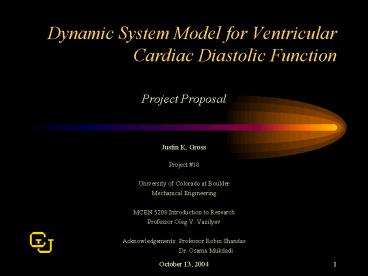Dynamic System Model for Ventricular Cardiac Diastolic Function - PowerPoint PPT Presentation
1 / 7
Title:
Dynamic System Model for Ventricular Cardiac Diastolic Function
Description:
... model to characterize the normal functioning of the heart during diastole. ... Model the right ventricle during diastole using a dynamic system model ... – PowerPoint PPT presentation
Number of Views:108
Avg rating:3.0/5.0
Title: Dynamic System Model for Ventricular Cardiac Diastolic Function
1
Dynamic System Model for Ventricular Cardiac
Diastolic Function
- Project Proposal
- Justin K. Gross
- Project 18
- University of Colorado at Boulder
- Mechanical Engineering
- MCEN 5208 Introduction to Research
- Professor Oleg V. Vasilyev
- Acknowledgements Professor Robin Shandas
- Dr. Osama Mukdadi
2
Problem/Questions
- To develop a mechanical systems model to
characterize the normal functioning of the heart
during diastole. - To alter this model to include heart pathologies.
- Can knowledge of mechanical functioning of the
heart be used to help diagnose heart pathologies?
3
Background
- Right ventricle pumps deoxygenated blood to the
lungs - Diastolic period when ventricles relax after
systolic contraction and fill with blood - Flow through atrioventricular valves
- Cardiac pathologies changes mechanical
functioning - Clinicians look at flow across atrioventricular
valve to aid in disease detection
4
Objectives
- Model the right ventricle during diastole using a
dynamic system model - Find parameters of the system
- Understand heart functioning for healthy and
unhealthy hearts - Which mechanical parameters change
- Understand correlated physiological changes
- Develop step towards a tool for diagnosis of
heart disease
5
Methodology
- Dynamic systems model of right ventricular
diastolic function - One dimensional
- Solve inverse problem using clinically obtained
data - Blood transvalvular flow velocities
(Echocardiography) - Tissue velocities (tissue Doppler)
- Determination of parameters m, c, k using certain
assumptions - Numerical data fitting using MATLAB
- Nonlinear solver
- Levenberg-Marquardt
- Statistical analysis to validate model with
actual cardiac data
Lisauskas JB, et al.
6
Timeline
7
References
- Lisauskas JB, Singh J, Bowman AW, Kovacs SJ.
Chamber properties from transmitral flow
prediction of average and passive left
ventricular diastolic stiffness. J Appl Physiol,
91154-1622001.































